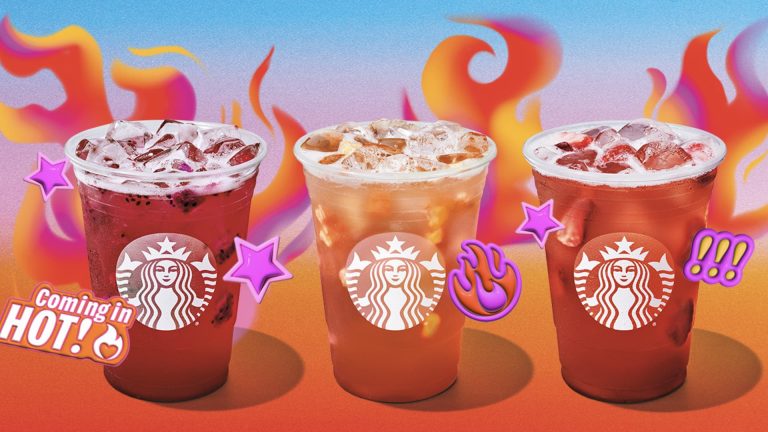This year’s hottest food and drink trend isn’t just spicy; it’s also sweet.
“Swicy,” a blend of sweet and spicy, has taken over restaurant marketing. Although the term hasn’t appeared on menus, it has become a popular shorthand for the resurgence of dishes that combine sweet and spicy flavors. The Food Institute even dubbed this summer the “Summer of Swicy.”
Nearly 10% of restaurant menus now feature “sweet and spicy” items, an increase of 1.8% over the past year, according to market research firm Datassential. Over the next four years, experts expect this trend’s menu penetration to rise by 9.6%.
Many restaurant chains have jumped on the trend, including Shake Shack with its swicy menu, Burger King with its Fiery Strawberry & Sprite, and Starbucks with its Spicy Lemonade Refreshers. These menus often combine fruity flavors with chili powder or feature sauces like hot honey and gochujang, a popular Korean red chili paste.
Although many of these items were available for a limited time, culinary experts believe the swicy trend has staying power.
Restaurants are placing greater importance on trendy menu items as they rely on both discounts and innovation to attract diners and counter declining sales. In August, traffic to U.S. restaurants fell by 3.6%, marking the industry’s second-worst monthly performance this year, according to Black Box Intelligence. Limited-time menu items particularly appeal to Gen Z customers, a crucial demographic that makes up roughly a fifth of Americans.
The ‘Swicy’ Story
Although the term “swicy” may be new, flavor pairings of sweet and spicy have existed for decades, says trendologist Kara Nielsen. The one element that has likely changed over time is the spice level.
“Food is definitely hotter now than it was 20 years ago,” Nielsen noted.
She recalls when Jeffrey Saad opened a fast-casual Mexican restaurant called Sweet Heat in San Francisco in 1993, long before he became a celebrity chef and Food Network star.
The resurgence of the sweet heat trend began around 2010, when Mike’s Hot Honey gained popularity, according to Nielsen. Additionally, Korean cuisine, particularly its sweet and spicy gochujang sauces, has attracted more people to this flavor combination.
The pandemic also pushed consumers back to classic comfort foods like burgers, fried chicken sandwiches, and pizza. However, as the desire for familiar favorites has faded, diners are now seeking novelty—or at least a twist.
“Now, four years on, we’re moving away from comfort foods and adding more spicy flavors,” Nielsen said.
Experts at McCormick first identified this reemerging trend in their 2022 flavor forecast report, according to Hadar Cohen Aviram, executive chef for the spice and flavoring company’s U.S. consumer division.
McCormick highlighted “plus sweet,” where sweetness enhances flavors rather than taking center stage. The forecasters considered naming the trend “swicy” in their report but chose “plus sweet” because it was broader.
In the following year, McCormick, which owns Frank’s RedHot and Cholula, pointed out “beyond heat,” which focuses on using other flavors to enhance the overall taste alongside spiciness.
“We see many different people wanting to add some heat to their plates, but they also want to ensure that there’s something for everyone,” Cohen Aviram said.
Gen Zwicy?
One reason many U.S. consumers seek out spicy foods and drinks is increasing diversity.
“The lasting appeal of sweet heat or swicy comes from its roots in traditional global cuisines like Mexican, Thai, and Korean, which many people with those ancestries know well. Then, these flavors get introduced and repackaged,” Nielsen explained.
For example, Shake Shack’s culinary team drew inspiration from Korean cuisine to create limited-time menu items, according to John Karangis, the company’s executive chef and vice president of culinary innovation.
One standout item was a Korean fried chicken sandwich, glazed in sweet and spicy gochujang. After launching this limited-time menu, Shake Shack’s marketing team pitted the chicken sandwich against the Korean BBQ burger, urging customers to choose a side: team swicy or team umami.
The swicy trend particularly attracts Gen Z, those born between 1997 and 2012.
“We have a new generation that’s excited about complex flavor profiles, but there are only so many you can taste: sweet, salty, bitter, umami,” Nielsen noted.
An example of this generation’s heat-seeking behavior: over half of Gen Z consumers identify as “hot sauce connoisseurs,” according to a survey by NCSolutions.
Achieving the perfect swicy balance can be challenging because it’s so personal, said McCormick’s Cohen Aviram.
Feedback from Shake Shack’s customers reflects this variability.
“Of course, we receive great feedback, but we also hear things like, ‘Hey, you could have punched it up a little bit,’” Karangis said.
When creating swicy concoctions, Cohen Aviram prefers a ratio of about 40% sweet to 60% spicy, as seen in her Frank’s RedHot ice cream bar.
“Sweetness can hijack your palate; if you use too much, you miss the nuance,” she explained.
When Burger King released its Fiery menu this summer, it ranked items on a spiciness scale. At one—meaning the least spicy—was the Fiery Strawberry & Sprite drink, inspired by another trend known as “dirty sodas,” which combine soda, creamers, and syrups that originated in Utah, according to Pat O’Toole, Burger King North America’s chief marketing officer.
This drink marked the first time Burger King modified a classic fountain beverage, though it had previously introduced a Frozen Fanta Kickin’ Mango with a similar swicy flavor profile.
“Guests can easily try a ‘swicy’ beverage and gradually explore spicier food options if they choose,” O’Toole said, noting that focus groups showed strong interest in a spicy Sprite.
However, not all swicy profiles resonate with customers. For instance, Coca-Cola discontinued its spiced Coke in September, just six months after its release, despite initially planning it as a permanent offering.
Despite some missteps, the swicy pairing is likely here to stay—for now.
“The flavors will stick around, for sure. The name might get tiresome, but I think it still has a couple of years left,” Nielsen predicted.

